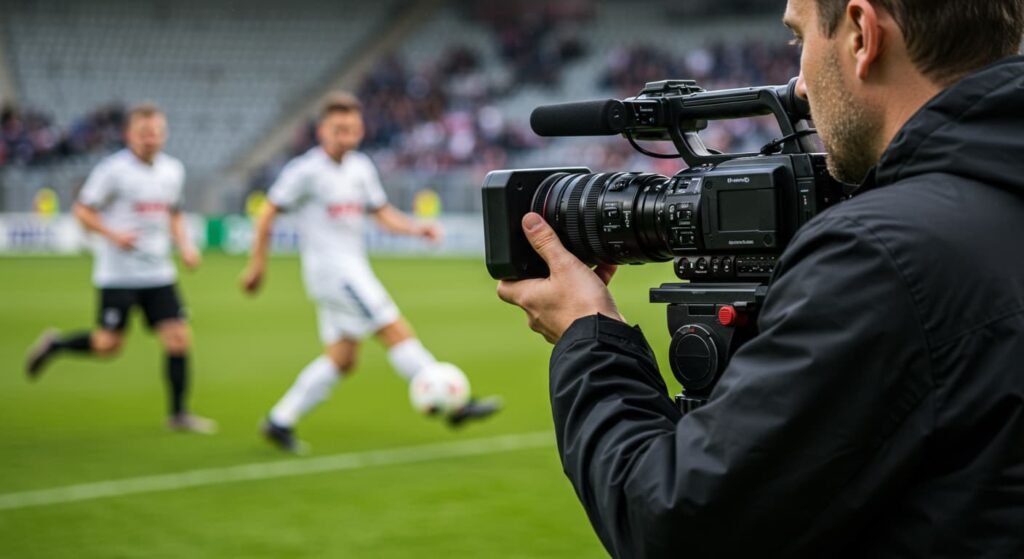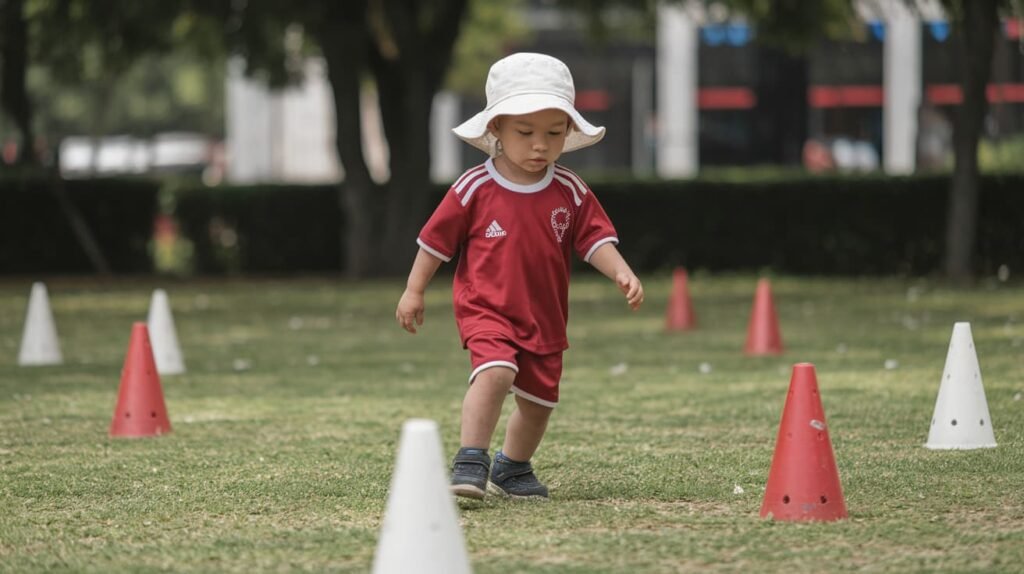In the heart of every thrilling sports moment—whether it’s a buzzer-beater in basketball or a last-second goal in soccer—a sports videographer is there, turning split-second action into unforgettable stories.
This isn’t just about recording a game; it’s about weaving technical precision, creative flair, and a passion for sports into footage that captivates fans and empowers athletes. From local high school matches to global championships, sports videographers are the masterminds behind the clips that spark excitement, drive training, and immortalize victories.
In this article, we’ll dive into what it means to be a sports videographer, explore its benefits and applications, share best practices, and look at the challenges and future of this dynamic field.
What is a Sports Videographer?

A sports videographer is a professional who specializes in filming athletic events, practices, and related activities. Their job is to capture the action, emotion, and energy of sports in a way that engages viewers, whether it’s for live broadcasts, social media clips, or archival purposes.
Unlike casual videographers, sports videographers need a keen understanding of the game they’re filming—anticipating plays, knowing where to aim the lens, and reacting in real time to unpredictable moments.
The role demands more than just hitting record. Sports videographers use advanced cameras, drones, and editing software to craft polished footage. They might work solo at a local game or as part of a larger production crew for televised events.
Some focus on creating cinematic highlight reels, while others produce raw footage for coaches to analyze player performance. It’s a versatile gig that requires adaptability, quick thinking, and a knack for storytelling through visuals.
Think of a sports videographer as a storyteller with a camera. They don’t just document the score—they capture the tension of a tied game, the joy of a last-second goal, or the grit of an underdog’s comeback. Their work brings fans closer to the action and helps athletes and coaches refine their craft.
Benefits and Applications of Sports Videography
Sports videography is the heartbeat of the sports world, transforming fleeting moments into lasting memories and powerful tools. It’s not just about capturing the action—it’s about fueling fan excitement, sharpening athletic performance, and building brands.
From iconic highlight reels to game-changing analysis, the work of a sports videographer ripples far beyond the field. Here’s a breakdown of why this craft is so vital and how it’s applied:
- Preserving Iconic Moments: A perfectly timed shot—like a game-winning dunk or a photo-finish sprint—can become legendary. These clips are shared across platforms, cherished by fans, and etched into sports history, keeping the thrill alive long after the game ends.
- Fueling Performance Analysis: Coaches and athletes depend on video to dissect every play. Footage reveals weaknesses, refines strategies, and sharpens skills. Whether it’s slow-motion analysis of a soccer player’s footwork or a basketball team studying defensive gaps, videographers provide the raw material for a competitive edge.
- Powering Marketing and Fan Engagement: Social media thrives on short, electrifying clips of jaw-dropping plays or candid behind-the-scenes moments. Teams and organizations use this content to build their brand, attract sponsors, and forge deeper connections with fans, amplifying their reach and impact.
- Supporting Broadcast Excellence: Broadcasters rely on videographers for high-quality footage that drives live games, replays, and in-depth analysis. Crisp, well-shot video ensures viewers stay glued to the action, whether they’re watching at home or streaming on the go.
- Offering a Rewarding Career Path: For those who love sports and storytelling, sports videography is a dream job. It blends high-energy environments, travel to exciting events, and the chance to create work that resonates with millions.
Best Practices for Sports Videographers
To excel as a sports videographer, you need more than a fancy camera—you need strategy, preparation, and finesse. Here are some practical tips to elevate your game:
- Know the Sport: Before filming, study the rules, key players, and typical flow of the game. If you’re shooting volleyball, know when to expect a spike. For football, anticipate where the ball might go after a snap..
- Master Your Gear: Familiarize yourself with your camera’s settings, lenses, and accessories. Practice switching between manual and auto modes to adapt to changing light or fast action. If you’re using a drone, ensure you’re licensed and know how to navigate safely around a crowded stadium.
- Plan Your Angles: Scout the venue ahead of time to identify the best vantage points. High angles capture the full scope of a play, while ground-level shots add drama and intensity. Mix wide shots and close-ups to keep the footage dynamic.
- Stay Alert and Mobile: Sports are unpredictable, so you need to stay on your toes. Keep your camera rolling during key moments and be ready to pivot if the action shifts. A steady hand (or a good gimbal) is crucial for smooth footage.
- Edit with Purpose: In post-production, trim the fat and focus on what matters. Highlight reels should be fast-paced and emotionally charged, while analysis footage needs clear, unembellished shots.
- Communicate with Your Team: If you’re part of a production crew, coordinate with directors, producers, and other videographers. Clear communication ensures everyone’s on the same page, especially during live events.
By honing these skills, you’ll produce footage that’s not only technically sound but also emotionally compelling.
Common Challenges and Future Directions

Sports videography is a thrilling but demanding craft, packed with obstacles and exciting possibilities. From grueling conditions to rapid tech advancements, videographers must adapt to stay ahead. Here’s a look at the key challenges and what lies on the horizon:
- Physical and Mental Endurance: Filming for hours in scorching heat or icy rain tests your stamina. Lugging heavy gear and staying sharp under pressure demands serious grit and focus.
- Technical Glitches: Cameras fail, batteries die, and lighting shifts unexpectedly. Videographers must troubleshoot on the spot, ensuring the footage keeps rolling without missing a beat.
- Pressure to Be Perfect: Missing a game-changing moment isn’t an option. The need to deliver flawless work in real time adds intense pressure to an already high-stakes job.
- Standing Out in a Crowd: With video content flooding platforms like YouTube and TikTok, videographers need unique angles, cutting-edge tech like 360-degree cameras, or a strong personal brand to shine.
- Emerging Technologies: Drones, AI cameras, and virtual reality are revolutionizing the field. These tools promise immersive fan experiences and smarter coaching insights but require constant learning to master.
- Rise of Digital Media: Streaming platforms and social media demand fast, high-quality content. Videographers must balance creating bite-sized clips and live streams with maintaining top-notch production value.
The road ahead for sports videographers is as challenging as it is exciting, with new tools and platforms reshaping how the game is captured and shared.
Conclusion
Being a sports videographer is about capturing the heart-pounding moments that define sports. It’s a role that blends technical expertise, creative vision, and a passion for the game. From producing highlight reels that ignite fan excitement to providing coaches with game-changing insights, sports videographers make a lasting impact.
By mastering best practices and navigating challenges, they turn fleeting moments into stories that endure. As technology and media evolve, the role of the sports videographer will only grow, offering new ways to bring the thrill of the game to life.
So, next time you watch a jaw-dropping replay, tip your hat to the person behind the lens—they’re the ones making the magic happen.



